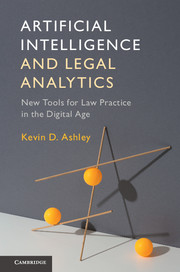Book contents
- Frontmatter
- Dedication
- Contents
- List of illustrations
- List of tables
- Acknowledgments
- PART I COMPUTATIONAL MODELS OF LEGAL REASONING
- 1 Introducing AI & Law and Its Role in Future Legal Practice
- 2 Modeling Statutory Reasoning
- 3 Modeling Case-based Legal Reasoning
- 4 Models for Predicting Legal Outcomes
- 5 Computational Models of Legal Argument
- PART II LEGAL TEXT ANALYTICS
- PART III CONNECTING COMPUTATIONAL REASONING MODELS AND LEGAL TEXTS
- Glossary
- Bibliography
- Index
2 - Modeling Statutory Reasoning
from PART I - COMPUTATIONAL MODELS OF LEGAL REASONING
Published online by Cambridge University Press: 13 July 2017
- Frontmatter
- Dedication
- Contents
- List of illustrations
- List of tables
- Acknowledgments
- PART I COMPUTATIONAL MODELS OF LEGAL REASONING
- 1 Introducing AI & Law and Its Role in Future Legal Practice
- 2 Modeling Statutory Reasoning
- 3 Modeling Case-based Legal Reasoning
- 4 Models for Predicting Legal Outcomes
- 5 Computational Models of Legal Argument
- PART II LEGAL TEXT ANALYTICS
- PART III CONNECTING COMPUTATIONAL REASONING MODELS AND LEGAL TEXTS
- Glossary
- Bibliography
- Index
Summary
INTRODUCTION
The Law is a domain of rules, and many of those legal rules are embodied in statutes and regulations. Since rules can be expressed logically and computers can reason deductively, computationally modeling statutory reasoning should be easy. One simply inputs a fact situation to the computer program; the program identifies the relevant rules, determines whether or not the rules’ conditions are satisfied, and explains the answer in terms of the rules that applied or did not apply.
Building a computational model of statutory reasoning, however, presents challenges. As explained below, statutes routinely are vague, syntactically ambiguous as well as semantically ambiguous, and subject to structural indeterminacy. If a computer program is to apply a statutory rule, which logical interpretation should it apply, how can it deal with the vagueness and open-texture of the statute's terms, or determine if there is an exception?
The chapter draws a contrast between deductively applying a statute and the complex process of statutory interpretation, which frequently involves conflicting reasonable arguments. Classical logical models may break down in dealing with legal indeterminacy, a common feature of legal reasoning: even when advocates agree on the facts in issue and the rules for deciding a matter, they can still make legally reasonable arguments for and against a proposition.
Reasoning with statutes, however, remains a pressing necessity. The chapter examines various AI & Law approaches that address or finesse these issues: a normalization process for systematically elaborating a statute's multiple logical versions, a logical implementation for applying a statute deductively, and more recent models of business process compliance and network-based statutory modeling, both potentially useful for cognitive computing.
Questions addressed in this chapter include: How can statutory rules be ambiguous, both semantically and syntactically? How do lawyers deal with these ambiguities, and how can computer programs cope? What are normalized legal drafting, Prolog, and a Prolog program? What is depth-first search and how does it differ from breadth-first search? What is legal indeterminacy and why is it a problem for logical models of legal reasoning? How can logic programs assess business process compliance with regulations? What problems do isomorphic knowledge representations of statutes address? What are citation networks and statutory network diagrams, and how can they support cognitive computing?
Information
- Type
- Chapter
- Information
- Artificial Intelligence and Legal AnalyticsNew Tools for Law Practice in the Digital Age, pp. 38 - 72Publisher: Cambridge University PressPrint publication year: 2017
Accessibility standard: Unknown
Why this information is here
This section outlines the accessibility features of this content - including support for screen readers, full keyboard navigation and high-contrast display options. This may not be relevant for you.Accessibility Information
- 1
- Cited by
